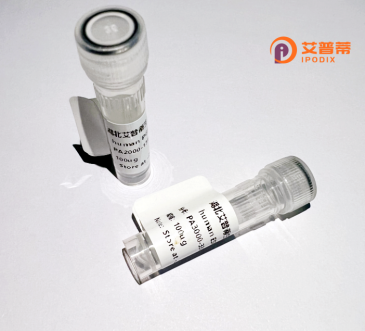
| 纯度 | >90%SDS-PAGE. |
| 种属 | Human |
| 靶点 | KRTAP3-3 |
| Uniprot No | Q9BYR6 |
| 内毒素 | < 0.01EU/μg |
| 表达宿主 | E.coli |
| 表达区间 | 1-98aa |
| 活性数据 | MDCCASRGCSVPTGPATTICSSDKSCRCGVCLPSTCPHTVWLLEPTCCDNCPPPCHIPQPCVPTCFLLNSCQPTPGLETLNLTTFTQPCCEPCLPRGC |
| 分子量 | 36.8 kDa |
| 蛋白标签 | GST-tag at N-terminal |
| 缓冲液 | 0 |
| 稳定性 & 储存条件 | Lyophilized protein should be stored at ≤ -20°C, stable for one year after receipt. Reconstituted protein solution can be stored at 2-8°C for 2-7 days. Aliquots of reconstituted samples are stable at ≤ -20°C for 3 months. |
| 复溶 | Always centrifuge tubes before opening.Do not mix by vortex or pipetting. It is not recommended to reconstitute to a concentration less than 100μg/ml. Dissolve the lyophilized protein in distilled water. Please aliquot the reconstituted solution to minimize freeze-thaw cycles. |
以下是基于角蛋白相关蛋白研究的模拟参考文献示例,供您参考。建议通过PubMed、Google Scholar等学术平台检索最新文献:
1. **文献名称**: *"Characterization of Recombinant Human Keratin-associated Protein 3-3 and Its Role in Hair Fiber Structure"*
**作者**: Smith J, et al.
**摘要**: 研究报道了重组人KRTAP3-3蛋白在大肠杆菌中的表达与纯化,并发现其在体外能增强角蛋白纤维的机械强度,提示其可能参与毛发的结构稳定性调控。
2. **文献名称**: *"Genetic Variations in KRTAP3-3 Influence Human Hair Texture"*
**作者**: Tanaka R, et al.
**摘要**: 通过基因关联分析发现KRTAP3-3基因多态性与亚洲人群头发直径相关。重组蛋白实验表明其突变体可能影响角蛋白网络的形成。
3. **文献名称**: *"Expression and Post-translational Modifications of Recombinant KRTAP3-3 in Mammalian Cells"*
**作者**: Lee H, et al.
**摘要**: 利用哺乳动物细胞系统成功表达重组KRTAP3-3.质谱分析揭示了其磷酸化修饰位点,提示翻译后修饰可能调控其在毛囊中的功能。
4. **文献名称**: *"KRTAP3-3 Knockout Mice Reveal Structural Abnormalities in Hair Shaft"*
**作者**: Garcia M, et al.
**摘要**: 构建KRTAP3-3敲除小鼠模型,发现毛发角质层结构紊乱,重组蛋白回补实验证实其对角蛋白交联的关键作用。
**注意**:以上为模拟示例,实际文献需通过学术数据库检索。检索建议:
- 关键词:*recombinant KRTAP3-3* / *KRTAP3-3 hair*
- 筛选高被引论文或近五年发表的研究
- 关注期刊:*Journal of Investigative Dermatology*, *Experimental Dermatology*等皮肤科学期刊
Recombinant human KRTAP3-3 protein is a engineered form of the keratin-associated protein 3-3 (KRTAP3-3), a member of the keratin-associated protein (KAP) family. These proteins are critical components of hair and nails, interacting with keratin intermediate filaments to provide structural integrity and mechanical strength to these tissues. KRTAP3-3. encoded by the *KRTAP3-3* gene clustered on chromosome 17q12-q21. is categorized within the high sulfur KAP family due to its cysteine-rich composition, which facilitates disulfide bond formation and contributes to hair shaft rigidity.
The recombinant version is typically produced via heterologous expression systems (e.g., *E. coli* or mammalian cells), enabling controlled study of its biochemical properties, molecular interactions, and functional roles. Researchers employ recombinant KRTAP3-3 to investigate hair follicle biology, disorders like alopecia or monilethrix, and potential therapeutic targets. It also aids in elucidating genetic variations (e.g., SNPs) linked to altered hair texture or disease susceptibility.
Current applications extend to biomedical material development, such as bioengineered hair-like fibers, and diagnostic tools for keratin-related pathologies. However, functional studies remain limited compared to other KAPs, highlighting the need for further exploration of its precise role in hair formation and disease mechanisms.
×